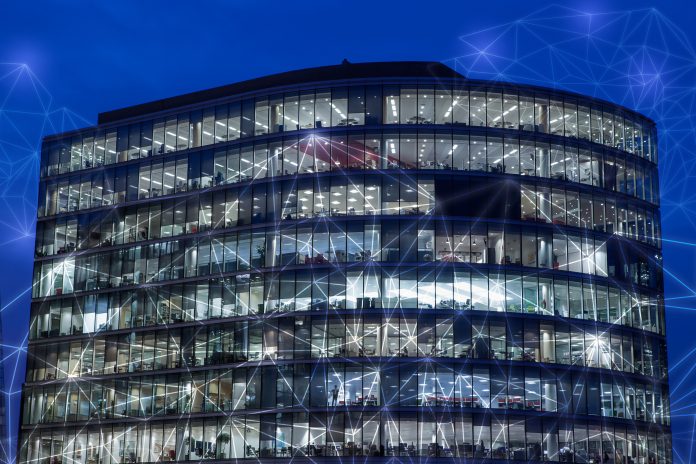Nick Sacke, Head of IoT Solutions, Comms365, outlines the numerous benefits that can be unlocked from smart building technology & the smart cities they are located within
The topic of ‘smart buildings’ has dominated IoT conversation since 2015, with analysts discussing how building owners will be able to leverage IoT technology to deliver a more efficient and monetisable structure, coupled with greater occupant satisfaction. Paving the way for digital transformation across smart buildings is the use of the Internet of things (IoT) technology and smart sensors. We have already witnessed an increasing demand for smart buildings, with the global market reaching a value of nearly $36.42 billion in 2020, and is expected to reach $59.30 billion in 2025.
As energy costs rapidly increase, and environmental issues remain a major concern across the world, there is rising pressure for increased uptake in energy-saving and cost-effective solutions, particularly across smart buildings and cities. Here, I will outline the numerous benefits that can be unlocked from smart building technology, and the smart cities they are located within.
Making offices safe
Especially as businesses begin to return to their offices after lockdown restrictions ease, technology will play a key role in this transition to ensure it is done safely. For shared office space, the automation of shared touchpoints such as door handles, elevators and sanitary systems is a straightforward way to limit cross-contamination. Technology can also be used to monitor hand soap and sanitiser bottle fill levels, monitor and alarm the mandatory two-metre distance between people via infrared beams, and analyse movement around the office and density in recreational areas by thermal imaging camera systems.
Specialist equipment is also being deployed to take temperature readings of employees and visitors to detect high temperatures, which is a key sign of being positive for COVID-19. Room sensors could be deployed in offices to measure humidity and temperature levels and send alerts when the best conditions for virus multiplication are being reached, so that evasive steps can be taken.
Transforming social housing
The opportunity for IoT technology in social housing can also be transformative, with the potential to make developments safer, more energy-efficient and, therefore, cheaper to run. Smart sensors can be used to measure and gather data from several property management parameters including temperature, humidity, carbon dioxide levels, noise and people movement. This data can then be shared with providers who can feed it into the network, benefiting not only tenants who can control their usage and bills through increased access to applications on their smartphones, but also housing associations, who can use the data insights for predictive maintenance, allowing for operational agility and highly effective resource allocation. For example, sensors can identify whether humidity levels are creating an environment for damp and mould, which, if left would not only incur repair costs but also potentially cause health issues, leading to more expenses over time, such as insurance claims.
By interfacing IoT-enabled devices to a building management system, key data parameters can be used to anticipate needs, take the requisite action and control the entire process from end to end. Whilst this involves monitoring a level of personal information, with data protection legislation in place, individuals cannot be identified, but can still play their part in the smart building measurement model.
Furthermore, the lower costs of running building utilities can be passed on in part through lower fees to the customer, boosting appeal and improving the customer experience. Therefore, identifying the value in IoT and understanding how these technologies can deliver potential efficiencies, reduce costs and monetise additional services, generating further revenue streams, can play a big role for many building owners in justifying the initial capital investment. This was highlighted in the recent Smart Buildings report, which discusses valuable opportunities in the smart buildings market, with the building energy management system being a key area, expecting to gain $10.6 billion of global annual sales by 2025.
The future of smarter lighting
Within the UK market, we’re seeing a big push towards creating even smarter lighting installations. The deployment of low energy bulbs has already been completed by many councils but being able to switch on and off certain sections of the lighting estate depending on the activity can go much further in reducing energy consumption, such as streetlights having interfaced ‘smart’ controllers that receive and transmit wireless signals to the lighting unit. The push towards smart lighting will use low power IoT networks to connect the lights, which will be undertaken on a huge scale, as even the smallest councils will enable over 10,000 streetlights. With such a focus on reducing energy consumption to meet national targets, this will soon become a priority.
Environmental monitoring
As we strive towards a greener future, and with heavy regulations coming into place around air quality, there is a need for local authorities to be more proactive and involved in the health of their citizens. By tracking environmental elements such as pollution levels, CO2 concentrations in offices and classrooms and chemical pollutants, environmental monitoring will become a big part of both our indoor and outdoor future.
Reducing pollution is paramount to the future of smart cities. The European Environmental Agency (EEA) reported that battery-powered electric vehicles have a net positive impact on air pollution, and many cities are pushing to increase the usage of electric mobility. This, when combined with government partnered IoT driven air quality solutions, becomes an increasingly valuable solution to mitigate the impact of air pollution.
Conclusion
With consistent technological developments, IoT is evolving to meet ever more stringent requirements and business challenges. Many cities have already taken the first step towards integrating IoT solutions into their operations and ecosystems, realising tangible benefits. We’re not only seeing an uptake in the adoption of these types of solutions, but the actual IoT technology design itself is becoming increasingly innovative, cost-effective, simple to deploy and maintain. The building managers that can embrace IoT technology solution design and deploy at scale, will deliver enhanced capacity and be able to manage more complex operational processes. The outcome will be to unlock significant benefits, including improvements to energy use, hyper-efficient and automated operational processes, resulting in cost savings both short- and long-term.











